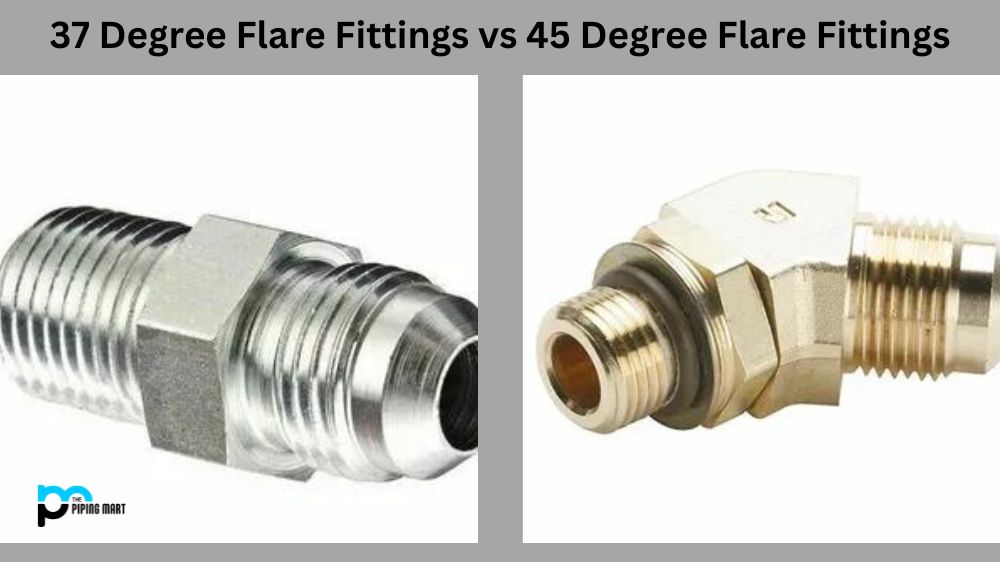When designing and building fluid power systems, a good understanding of fittings and connectors is essential. Flared fittings are widely used in hydraulic and pneumatic applications, but not all are created equal. The two most common types of flared fittings are the 37 degree flare and the 45 degree flare. In this article, we’ll explore the key differences between these two types of flared fittings to help you better understand which one to use in your application.
37 Degree Flare
37 Degree Flare is a type of fitting used to connect pipes and other pieces of equipment. It is made up by cutting two separate pieces of pipe or tube to form the connection, creating a 37 degree angled flare at the end of each piece, and finally using an adapter nut to seal it all together. The advantage this type of connection has over other types, such as butt-welded or threaded connections, is that it allows for better flexibility when connecting the pipes without compromising their structural integrity. Additionally, since these fittings are designed to not require welding or specialized tools, they can be installed quickly and easily with minimal hassle.
45 Degree Flare
45 Degree Flare is a type of fitting used to join two pipes or tube sections. It’s created by forcing the tube end into a cone shape to fit into the other pipe or part. These flares create a leak-tight seal and are especially useful in hydraulic systems. Additionally, they are resistant to mechanical stress like vibration, pressure surges and erosive environments. While 45 Degree Flares can be custom-made according to specifications, they are most commonly seen in sizes such as ¼”, 3/8”, and ½” inch pipe thread standards.
Difference Between 37 Degree Flare and 45 Degree Flare
Angle of Flare
The key difference between a 37 degree flare and a 45 degree flare is the angle of the flare itself. A 37 degree flare has a slightly more acute angle, which allows for tighter clamping, better sealing, and greater vibration resistance. On the other hand, a 45 degree flare has a more open angle, making it easier to assemble and disassemble and more forgiving in terms of alignment. Both types of flares are used in different applications depending on their advantages and disadvantages.
Tubing Requirement
Another difference to consider between 37 degree flares and 45 degree flares is the type of tubing required with each fitting. A 37 degree flare requires SAE standard tubing, while a 45 degree flare accommodates both SAE standard tubing and DIN 2353 metric tubing. Choosing the correct type of tubing for your flare fitting is important to ensure proper compatibility and reliability in your fluid power system.
Torque Specifications
The torque specification for tightening each flare is also something to remember. 37 degree flares have a higher recommended torque value than 45 degree flares. This is because a 37 degree flare design provides more contact between the flare and fitting, requiring more force to achieve a proper seal. However, it is important not to overtighten fittings, as they can cause damage that can lead to leaks.
Seal Integrity
Finally, the seal integrity of 37 degree flares and 45 degree flares is different because of the angle of the flare. A 37 degree flare is more suitable for high-pressure applications that require a tighter seal, as it provides a more secure connection due to the tighter clamping force between the flare and the fitting. On the other hand, a 45 degree flare is more suited for low-pressure applications as it has a wide opening that makes for easier installation, maintenance, and disassembly.
Conclusion:
In conclusion, 37- and 45 degree flares are two of fluid power systems’ most commonly used flared fittings. Understanding the differences between these two flares can help you select the right fitting for your application, ensuring it is reliable, leak-free, and efficient. The choice between a 37 degree flare and a 45 degree flare ultimately depends on the specific needs of your fluid power system. Therefore, it is essential to consider factors such as tubing requirements, torque specifications, and seal integrity when selecting a flare fitting.

A passionate metal industry expert and blogger. With over 5 years of experience in the field, Palak brings a wealth of knowledge and insight to her writing. Whether discussing the latest trends in the metal industry or sharing tips, she is dedicated to helping others succeed in the metal industry.




